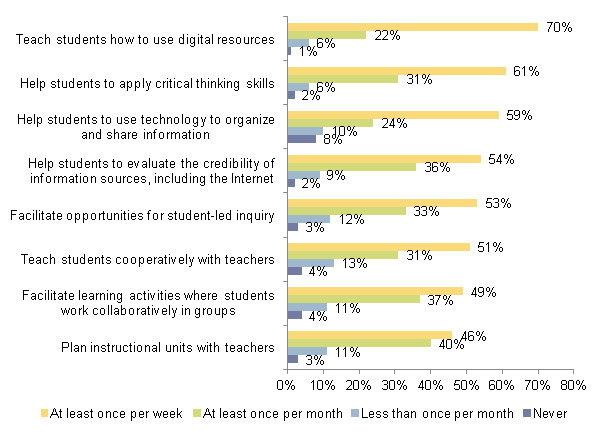The Colorado Department of Education (CDE) and the American Association of School Libraries (AASL) have both established standards to guide educators in fostering their students’ development of 21st-century skills. In order to demonstrate the critical role of school librarians in this process, it is important to establish the extent to which they are engaging in activities to meet these standards.
In 2011-2012, 442 school librarians[note]That is, school librarians/teacher librarians with CDE school library endorsements.[/note] participated in the annual Colorado School Library Survey. The survey included a new section that focused on 21st-century instruction strategies. Respondents were asked how often they engaged in the eight strategies listed below, which reflect the CDE and AASL standards.
• Teach students how to use digital resources
• Help students to apply critical thinking skills
• Help students to use technology to organize and share information
• Help students to evaluate the credibility of information sources, including the Internet
• Facilitate opportunities for student-led inquiry
• Teach students cooperatively with teachers
• Facilitate learning activities where students work collaboratively in groups
• Plan instructional units with teachers
Results
The most frequent activity across Colorado public school libraries with endorsed librarians, regardless of grade level or enrollment, was “teach students to use digital resources”; 7 in 10 respondents reported helping students develop this skill at least once a week. About 3 in 5 respondents reported that they help students apply critical thinking skills (61%) and use technology to organize and share information (59%) at least once a week.
Respondents engaged least frequently in the activities “plan instructional units with teachers” and “facilitate learning activities where students work collaboratively in groups;” however, close to half of them reported doing these at least weekly. Chart 1 further breaks down how often school librarians engaged in the eight teaching strategies during the 2011-2012 school year.
Chart 1
Frequency of Teaching Strategies of Endorsed School Librarians
In Colorado Public Schools
 Differences by Grade Level and Enrollment
Differences by Grade Level and Enrollment
The three most and least common teaching methods remained more or less consistent regardless of grade level and enrollment, but some differences in the overall levels of library instruction emerged among different types of schools. Endorsed librarians at the secondary level, for example, engaged most often in these activities, with as many as four-fifths (82%) of respondents from high school libraries and nearly three-fourths (72%) of respondents from middle school libraries participating in some type of them at least once a week. Elementary schools and combined schools (schools containing grades within both primary and secondary levels, e.g., K-8 schools) reported conducting library instruction less often than secondary schools. Two-thirds of respondents (67%) from elementary schools and a little more than 3 in 5 respondents (63%) from combined schools reported that they engaged in some type of these activities at least once a week. High school librarians were especially focused on helping students to use digital resources (4 in 5 engaged in this activity at least once a week) and to evaluate the credibility of information sources (3 in 4 taught these skills at least once a week).
The frequency with which endorsed school librarians engaged in these activities also differed based on enrollment. Librarians at large schools (1,000 students or more) engaged in these strategies most frequently. More than 4 in 5 respondents (82%) from these schools engage in one or more of these teaching activities at least once a week, while this number drops to 3 in 5 (60%) in medium-sized schools (500-999 students), and to a little under half (47%) in schools with fewer than 500 students.
Conclusion
Overall, according to these survey results, endorsed school librarians in Colorado are engaging in a variety of teaching activities that help students to acquire 21st-century skills. They are most frequently engaging in activities such as teaching students about using digital resources and critical thinking, but are collaborating with teachers less often. Students in large schools and at the secondary level have the greatest advantages in library instruction. In contrast, elementary school students and students in combined and/or small schools are less likely to encounter 21st-century instruction strategies in their school libraries.
When considering these results, it is important to keep in mind the challenges that schools face in the current economy with regards to funding for resources and staffing, and how they limit the extent to which school libraries can implement 21st-century instruction strategies. Small schools may be particularly vulnerable to such challenges. Therefore, stakeholders should carefully consider how access to funding and other resources impact school libraries and student academic achievement.
Looking forward, these results may be used to direct the professional development activities of school librarians to better align their skills with current educational standards. In addition, as these instruction strategies become more fully implemented, the survey results may help to demonstrate the central role of school librarians in imparting 21st-century skills to students.